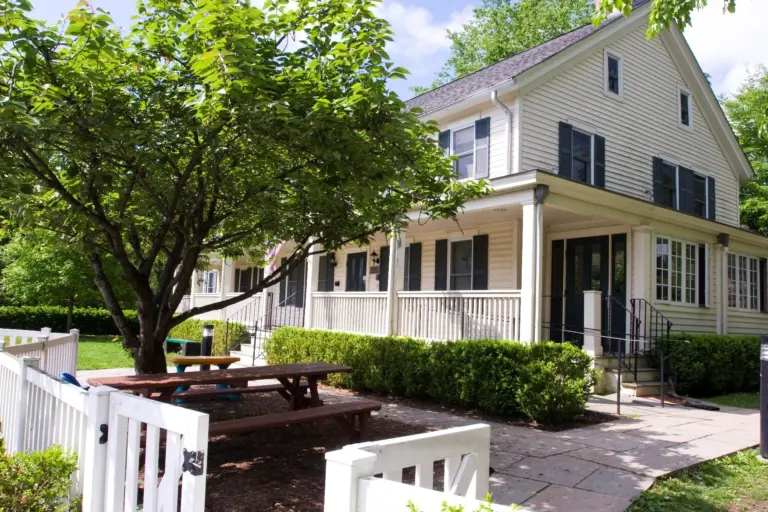In honor of Women’s History Month, the Greenwich Library Oral History Project is featuring its blog on Meredith Sampson, wildlife rehabilitator as written by OHP editor Mary Jacobson. Sampson was interviewed by OHP volunteer Sally McHale on June 5, 2018.
Meredith Sampson oversees the non-profit Wild Wings LLC as wildlife rehabilitator and environmental educator. She is often the person called upon to help when someone encounters a lost, injured, or orphaned baby bird, squirrel, or owl. It is not unusual for her to find small animals left at her door by a well-meaning person who is uncertain of what to do to help them.
With birds, Ms. Sampson advises people to first determine the baby bird’s condition and age. If it is uninjured and not too young, it can be placed near the next area so that the bird’s parents may do their job of caring for it. Excessive handling, feeding, or moving of the bird can put it in a more precarious position. If, however, the animal is in need of care, Ms. Sampson suggests “If you’ve found injured or orphaned wildlife or wildlife that you think might need help, get it into a secure container that’s well ventilated and put it somewhere in a quiet, warm place and keep it away from people and pets. Then call me.” After rehabilitating the bird, Ms. Sampson would then release it into its habitat.
Ms. Sampson also initiated the First Sunday Bird Walks at Greenwich Point Park in 2005 under the original co-sponsorship of Wild Wings, the Bruce Museum, and Greenwich Audubon Center. As of 2019, Friends of Greenwich Point became co-sponsor with Wild Wings. These bird walks are free and open to the public of all ages. They provide an opportunity to experience the amazing biodiversity of Greenwich Point with its beach, meadows, woodlands, and marshes. “It’s an extraordinary place. It’s like nature’s classroom,” says Sampson. It provides an opportunity to appreciate the effects of climate change on various species, the migration patterns of birds, as well as many other aspects of nature that may be otherwise overlooked in our day-to-day busy lives. In addition to observing bird life, participants observe the seasonal changes of insects including butterflies, plants, and other animals.
Ms. Sampson also works with the Audubon Center to do annual Christmas and Summer Bird Counts in our local area. She has been performing this valuable service for almost 40 years and has counted as many as 70 species in one area alone. Over the years, she has observed how changes in our environment have affected native species: “Whatever is happening in the environment can affect bird populations and this is something we need to pay attention to.”
For example, Ms. Sampson describes how the results of certain bird species counts may differ dramatically from year to year due to various causes—some understood, others not. When the West Nile virus became prevalent in our area in 1999, there was a dramatic drop in the bird count of crows, and a number were found unable to stand or fly and were having seizures before dying. After animal autopsies at University of Connecticut at Storrs and extensive research, it was determined that the birds had a virus that had infected an exotic bird from Africa housed at the Bronx Zoo and was carried by mosquitos to other bird species and, subsequently, to humans.
Questions arise when the migration patterns of certain bird species change. For example, why are wood thrushes no longer prevalent in our area? What happened to the population of yellow-throated warblers that used to be here in far greater number? Has their southern habitat been deforested? These are only some of the questions that can arise as one keenly observes the environment as Sampson does. She underscores the importance of understanding the relationship between what we do to our environment and how that affects the species that inhabit it.
Ms. Sampson also is a proponent of replanting native plants, trees, and shrubs in order to continue to provide the food and shelter that our birds and animals need to survive. This includes planting milkweed upon which monarch butterflies depend for food. She supports the removal of invasive plant species like garlic mustard and porcelain berry that choke our native ones. “The key factor of a successful habitat is that it provides shelter, food, and opportunity to reproduce. If any one of these links is broken, we witness dramatic effects,” she tells us.
In her interview, Ms. Sampson recounts many unusual and often humorous situations in her career as a wildlife rescuer and rehabilitator. One is the story of a creative rescue in Greenwich Point. It involved Ms. Sampson with a 60-foot-high crane, a wicker basket from McArdle’s, and a hapless baby owl that had fallen from its ill-made nest in Greenwich Point. Find out additional details by reading the transcript of her interview.
We have much to learn from the wealth of experience Meredith Sampson brings to our understanding of wildlife and its relationship to our environment. As she has said, “We need to seriously restore habitat and create new habitat. We’ve got to treat this earth with a lot more kindness. This is the only planet we have, the only home that we have. And this, all this, is what sustains us.”
As with all our interview transcripts, the Meredith Sampson transcript may be read at Greenwich Library and is available for purchase at the Oral History Project office. The Oral History Project is sponsored by the Friends of the Greenwich Library. Visit the OHP website at glohistory.org




